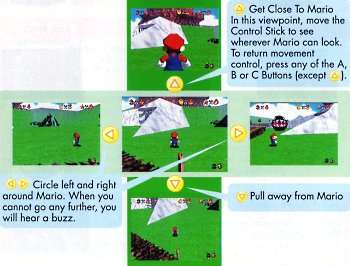Free Rotating Camera

The ability to rotate the camera independently around the player character in a third person 3D video game. The purpose is to allow the camera to face any direction the player chooses, no matter where the PC is facing. This flexibility has made it one of the most popular camera controls implemented to avoid Camera Screw (especially since it can just be mapped to the shoulder buttons or second analog stick).
It isn't perfect, though. It's not as fast as Camera Centering (why some games include both controls), and it's not always a good idea to rely too much on it, especially if the level design doesn't take these factors into account.
There are three main types of rotating (depending on control availability or designer choices):
- "Rotation Alone": Rotating circularly along the X-axis alone. Often all that is needed when a game is mostly on a flat plane or with limited platforming.
- "Rotation And Tilt": Rotating along the X-axis and tilting along the Y-axis. This is similar to the controls in a First-Person Shooter, and in fact some Third Person Shooters allow the player to move freely while using this control to aim the camera. But for most games, it's just to allow the player more viewing angles.
- The reason full circular tilting along the Y-axis isn't done is that it could go at angles that themselves would cause Camera Screw. Sometimes it's also used to prevent 'unfortunate' angles on female characters.
- "Rotation And Zoom": Rotating along the X-axis and zooming in and out along the Y-axis. This allows more visibility among open spaces, while using the close view in tight spaces. In some games, zooming in enough turns into a Freelook Button. This type is most common among Nintendo games.
A lot of Strategy RPGs let you rotate the field, tilt the view, and zoom.
Which button turns what direction depends on the setup of the game. "Standard" turning along the X-axis is pressing right turns the camera counterclockwise, and left clockwise. "Inverted" does the opposite (in a similar manner to turning with an FPS). Tilting on the Y-axis is also standard and inverted, with the latter being like a flight stick. Some games let you choose between standard and inverted controls. Games that don't can often lead to Damn You, Muscle Memory!.
Also, which buttons are used will, of course, vary depending on the games and controller. The standards are the shoulder buttons or right analog stick for gamepads, and the mouse or Q and E keys for PC games.
Compare 360-degree steadycam shots in movies, Always Over the Shoulder (the camera rotates with the player).
Contrast Fixed Camera.
Platformer
- Super Mario 64 uses "Rotation And Zoom", but is the Trope Maker for all of them, as the Guinness Book Of World Records has acknowledged it as the first game to feature a controllable camera.
- Super Mario Sunshine also uses "Rotation And Zoom".
- Super Mario Galaxy has "Rotation Alone" in areas where the camera isn't fixed.
- The first Spyro the Dragon game did "Rotation Alone" with two of the shoulder buttons, and the other two were strafing (by way of rolling). But for some reason, the next two did rotation for the other two shoulder buttons as well. Later games did "Rotation And Tilt" or "Rotation And Zoom".
- Ratchet and Clank games use "Rotation And Tilt" when in the "Third Person" camera mode.
- Sonic Adventure
- Sonic Heroes includes both this and shoulder camera rotation.
- Epic Mickey uses "Rotation And Tilt".
RPG
- The Kingdom Hearts games are all over the place.
- Kingdom Hearts and Kingdom Hearts: Birth By Sleep were "Rotation Alone".
- Kingdom Hearts II is "Rotation And Tilt".
- Kingdom Hearts 358 Days Over 2 used the shoulder buttons for either "Rotation Alone" or strictly Camera Centering (depending on the options you chose), but the touch screen could always be used for "Rotation And Tilt".
- Wild ARMs 2 and Wild ARMs 3 are "Rotation Alone".
- The Grandia games use "Rotation Alone", at least the main series games.
- Dragon Quest VIII uses "Rotation And Tilt". Other games use "Rotation Alone", like Dragon Quest VII and Dragon Quest IX.
- World of Warcraft uses "Rotation Alone".
- Final Fantasy XII
- Final Fantasy XIII
- Knights of the Old Republic series use "Rotation Alone".
Sandbox
- Grand Theft Auto games use II since Grand Theft Auto: San Andreas.
- No More Heroes, II
- Saints Row uses II unless in aiming modes.
Adventure
- The Legend of Zelda the Wind Waker and The Legend of Zelda: Twilight Princess use "Rotation And Zoom".
- Brave Fencer Musashi did this in a few areas.
- Crystal Bearers
- Vagrant Story
Real Time Strategy
- Warhammer 40000: Dawn of War and Warhammer 40000: Dawn of War 2 use a "Rotation And Zoom" camera when the player wants to do close ups on the action.
Edutainment Games
- Wolf Quest gives you the option of "Rotation Alone".